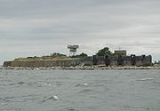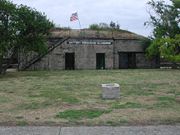
Fort Wool
Encyclopedia

Fort Monroe
Fort Monroe was a military installation in Hampton, Virginia—at Old Point Comfort, the southern tip of the Virginia Peninsula...
in protecting Hampton Roads
Hampton Roads
Hampton Roads is the name for both a body of water and the Norfolk–Virginia Beach metropolitan area which surrounds it in southeastern Virginia, United States...
from seafaring threats. This site was once the dumping place for ships’ ballast
Sailing ballast
Ballast is used in sailboats to provide moment to resist the lateral forces on the sail. Insufficiently ballasted boats will tend to tip, or heel, excessively in high winds. Too much heel may result in the boat capsizing. If a sailing vessel should need to voyage without cargo then ballast of...
.
Originally conceived in 1817, Fort Calhoun was built on a 15 acre
Acre
The acre is a unit of area in a number of different systems, including the imperial and U.S. customary systems. The most commonly used acres today are the international acre and, in the United States, the survey acre. The most common use of the acre is to measure tracts of land.The acre is related...
(61,000 m²) artificial island
Artificial island
An artificial island or man-made island is an island or archipelago that has been constructed by people rather than formed by natural means...
southeast of Old Point Comfort
Old Point Comfort
Old Point Comfort is a point of land located in the independent city of Hampton. It lies at the extreme tip of the Virginia Peninsula at the mouth of Hampton Roads in the United States....
in Hampton, Virginia
Hampton, Virginia
Hampton is an independent city that is not part of any county in Southeast Virginia. Its population is 137,436. As one of the seven major cities that compose the Hampton Roads metropolitan area, it is on the southeastern end of the Virginia Peninsula. Located on the Hampton Roads Beltway, it hosts...
. Construction and repairs continued for decades, because the foundation
Foundation (architecture)
A foundation is the lowest and supporting layer of a structure. Foundations are generally divided into two categories: shallow foundations and deep foundations.-Shallow foundations:...
was unstable. The first level of casemates was finished in 1830. Construction continued through the 1830s, when Andrew Jackson
Andrew Jackson
Andrew Jackson was the seventh President of the United States . Based in frontier Tennessee, Jackson was a politician and army general who defeated the Creek Indians at the Battle of Horseshoe Bend , and the British at the Battle of New Orleans...
came to escape from the heat of Washington, D.C.
Washington, D.C.
Washington, D.C., formally the District of Columbia and commonly referred to as Washington, "the District", or simply D.C., is the capital of the United States. On July 16, 1790, the United States Congress approved the creation of a permanent national capital as permitted by the U.S. Constitution....
As a young second lieutenant
Second Lieutenant
Second lieutenant is a junior commissioned officer military rank in many armed forces.- United Kingdom and Commonwealth :The rank second lieutenant was introduced throughout the British Army in 1871 to replace the rank of ensign , although it had long been used in the Royal Artillery, Royal...
and engineer
Engineer
An engineer is a professional practitioner of engineering, concerned with applying scientific knowledge, mathematics and ingenuity to develop solutions for technical problems. Engineers design materials, structures, machines and systems while considering the limitations imposed by practicality,...
in the U.S. Army, Robert E. Lee
Robert E. Lee
Robert Edward Lee was a career military officer who is best known for having commanded the Confederate Army of Northern Virginia in the American Civil War....
was stationed there from 1831 to 1834. Lee was an assistant to Captain Andrew Talcott
Andrew Talcott
Andrew Talcott was an American civil engineer and close friend of Civil War General Robert E. Lee. While serving as a Confederate States of America Colonel and the State Engineer of Virginia, he was arrested and made prisoner of war during that conflict.-Early life:Talcott was born on April 20,...
and played a major role in the final construction of both the fort on the island in 1834, and its larger opposite on the mainland, Fort Monroe.
The first fort was originally called Ripraps (a name still often used; see Rip Raps
Rip Raps
Rip Raps is a small 15 acre artificial island at the mouth of the harbor area known as Hampton Roads in the independent city of Hampton in southeastern Virginia in the United States.-History:...
for a possible history behind the name), and later Fort Calhoun. The Fort played a crucial role for the Union
Union (American Civil War)
During the American Civil War, the Union was a name used to refer to the federal government of the United States, which was supported by the twenty free states and five border slave states. It was opposed by 11 southern slave states that had declared a secession to join together to form the...
forces during the American Civil War
American Civil War
The American Civil War was a civil war fought in the United States of America. In response to the election of Abraham Lincoln as President of the United States, 11 southern slave states declared their secession from the United States and formed the Confederate States of America ; the other 25...
. In addition to aiding in controlling entrance to the harbor of Hampton Roads, prisoners were confined in the fort. After the Civil War it was named Fort Wool for the Union Major General
Major General
Major general or major-general is a military rank used in many countries. It is derived from the older rank of sergeant major general. A major general is a high-ranking officer, normally subordinate to the rank of lieutenant general and senior to the ranks of brigadier and brigadier general...
John Ellis Wool, who captured Norfolk
Norfolk, Virginia
Norfolk is an independent city in the Commonwealth of Virginia in the United States. With a population of 242,803 as of the 2010 Census, it is Virginia's second-largest city behind neighboring Virginia Beach....
in the early part of the war.
The Fort was modernized in the early 20th century, and served as the part of the harbor's defense during World War I
World War I
World War I , which was predominantly called the World War or the Great War from its occurrence until 1939, and the First World War or World War I thereafter, was a major war centred in Europe that began on 28 July 1914 and lasted until 11 November 1918...
and World War II
World War II
World War II, or the Second World War , was a global conflict lasting from 1939 to 1945, involving most of the world's nations—including all of the great powers—eventually forming two opposing military alliances: the Allies and the Axis...
. During World War I submarine nets
Indicator net
Constructed using light steel nets, indicator nets were often anchored at various depths to the sea bed around Allied naval bases during World War II...
were stretched across the harbor from this point. In the 1950s, the southern man-made island of the Hampton Roads Bridge-Tunnel
Hampton Roads Bridge-Tunnel
The Hampton Roads Bridge-Tunnel is the -long Hampton Roads crossing for Interstate 64 and U.S. Route 60. It is a four-lane facility comprising bridges, trestles, man-made islands, and tunnels under the main shipping channels for Hampton Roads harbor in the southeastern portion of Virginia in the...
was constructed next to Fort Wool, and used as the southernmost anchor for the tunnels. A small earthen causeway connected the man-made island with that of Fort Wool. The bridge-tunnel
Bridge-tunnel
A fixed link, fixed crossing, or bridge-tunnel is a persistent, unbroken road or rail connection across water that uses some combination of bridges, tunnels, and causeways and does not involve intermittent connections such as drawbridges or ferries.The Confederation Bridge was commonly referred to...
opened to traffic in 1957.
The outmoded fort was finally abandoned by the military in 1953. After being decommissioned, it was given to the Commonwealth of Virginia in 1967 and in 1970, the City of Hampton developed it into a park
Park
A park is a protected area, in its natural or semi-natural state, or planted, and set aside for human recreation and enjoyment, or for the protection of wildlife or natural habitats. It may consist of rocks, soil, water, flora and fauna and grass areas. Many parks are legally protected by...
. The Fort Wool passenger ferry
Ferry
A ferry is a form of transportation, usually a boat, but sometimes a ship, used to carry primarily passengers, and sometimes vehicles and cargo as well, across a body of water. Most ferries operate on regular, frequent, return services...
, Miss Hampton II, allows tourists boarding in Hampton to visit the island during most of the year, but it can also be briefly glimpsed by passengers in westbound vehicles prior to entering the southern end of the tunnel portion of the Hampton Roads Bridge-Tunnel, which carries Interstate 64
Interstate 64
Interstate 64 is an Interstate Highway in the Midwestern and Southeastern United States. Its western terminus is at I-70, U.S. 40, and U.S. 61 in Wentzville, Missouri. Its eastern terminus is at an interchange with I-264 and I-664 at Bowers Hill in Chesapeake, Virginia. As I-64 is concurrent with...
across the mouth of the harbor.
The island, now called Rip Raps
Rip Raps
Rip Raps is a small 15 acre artificial island at the mouth of the harbor area known as Hampton Roads in the independent city of Hampton in southeastern Virginia in the United States.-History:...
, continues to settle in modern times, and occasionally the casemates of the original fortress are put off-limits for safety reasons. It remains a major draw for tourists, who usually include it in a visit to Fort Monroe. During the summer months, it is served by various harbor tour boats.

